Impacts of Tourism: Economic, Social, and Environmental
VerifiedAdded on 2023/06/09
|7
|2212
|185
AI Summary
Tourism is a business that attracts, accommodates, and entertains tourists. It is a major industry that impacts the economy, society, and environment. This article discusses the positive and negative impacts of tourism on these aspects and the need for sustainable tourism.
Contribute Materials
Your contribution can guide someone’s learning journey. Share your
documents today.
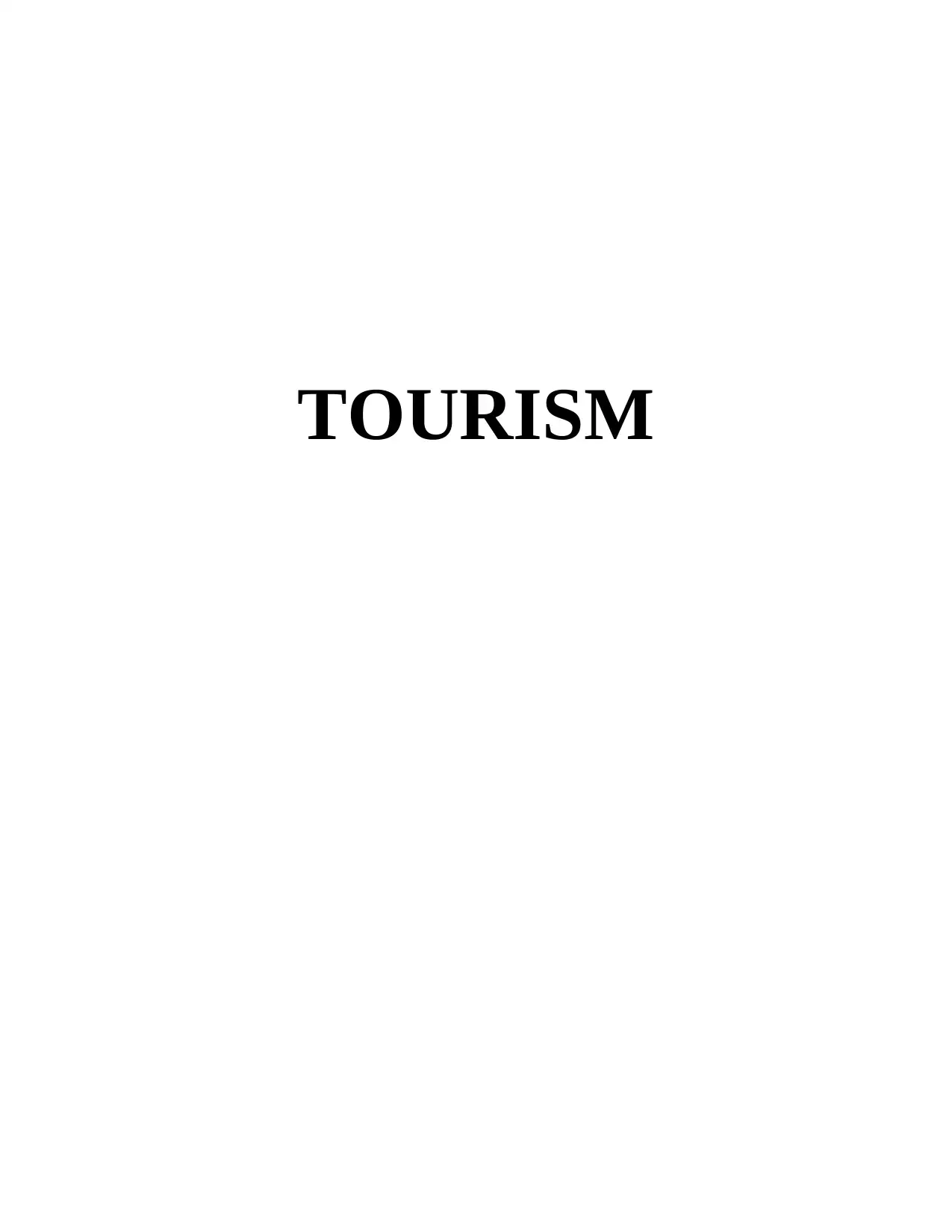
TOURISM
Secure Best Marks with AI Grader
Need help grading? Try our AI Grader for instant feedback on your assignments.
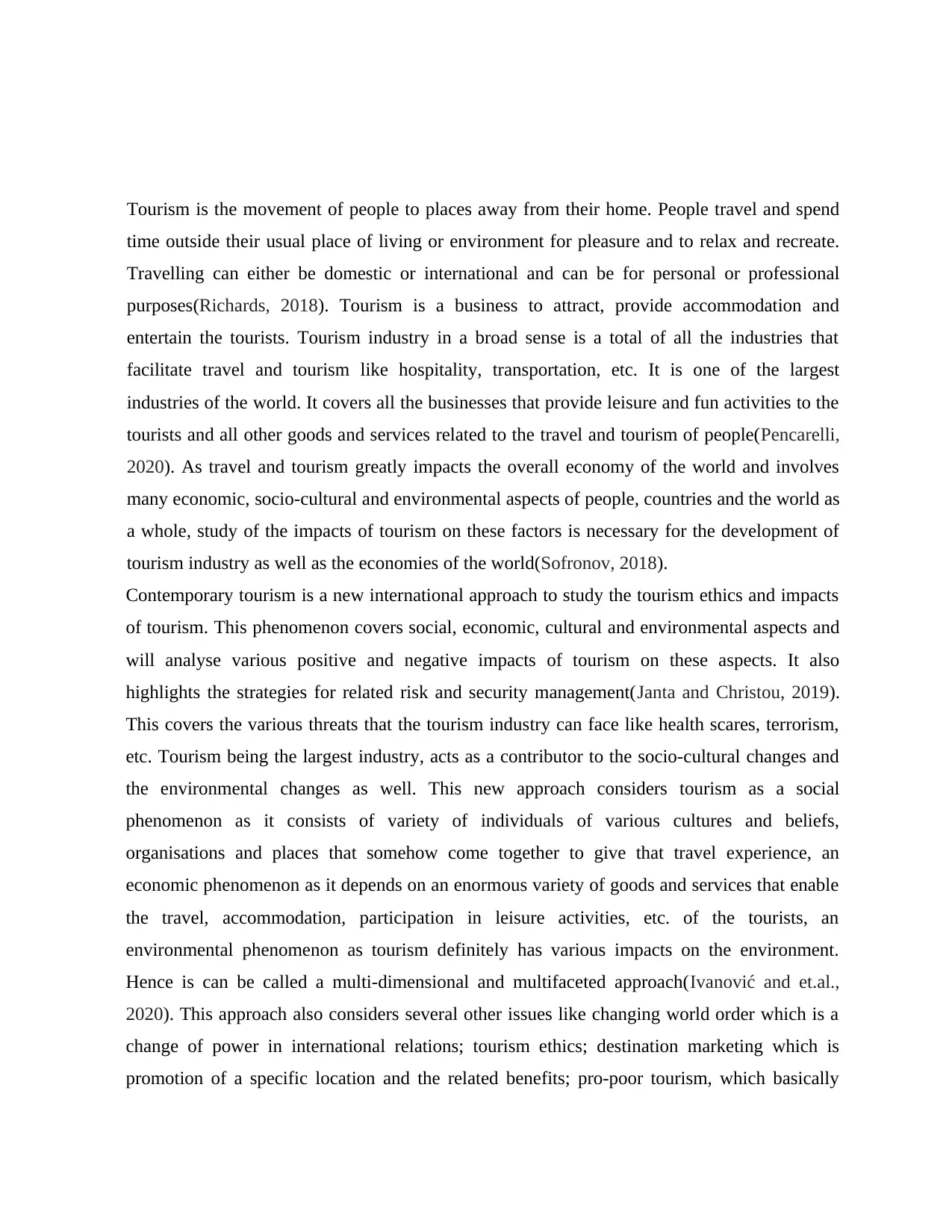
Tourism is the movement of people to places away from their home. People travel and spend
time outside their usual place of living or environment for pleasure and to relax and recreate.
Travelling can either be domestic or international and can be for personal or professional
purposes(Richards, 2018). Tourism is a business to attract, provide accommodation and
entertain the tourists. Tourism industry in a broad sense is a total of all the industries that
facilitate travel and tourism like hospitality, transportation, etc. It is one of the largest
industries of the world. It covers all the businesses that provide leisure and fun activities to the
tourists and all other goods and services related to the travel and tourism of people(Pencarelli,
2020). As travel and tourism greatly impacts the overall economy of the world and involves
many economic, socio-cultural and environmental aspects of people, countries and the world as
a whole, study of the impacts of tourism on these factors is necessary for the development of
tourism industry as well as the economies of the world(Sofronov, 2018).
Contemporary tourism is a new international approach to study the tourism ethics and impacts
of tourism. This phenomenon covers social, economic, cultural and environmental aspects and
will analyse various positive and negative impacts of tourism on these aspects. It also
highlights the strategies for related risk and security management(Janta and Christou, 2019).
This covers the various threats that the tourism industry can face like health scares, terrorism,
etc. Tourism being the largest industry, acts as a contributor to the socio-cultural changes and
the environmental changes as well. This new approach considers tourism as a social
phenomenon as it consists of variety of individuals of various cultures and beliefs,
organisations and places that somehow come together to give that travel experience, an
economic phenomenon as it depends on an enormous variety of goods and services that enable
the travel, accommodation, participation in leisure activities, etc. of the tourists, an
environmental phenomenon as tourism definitely has various impacts on the environment.
Hence is can be called a multi-dimensional and multifaceted approach(Ivanović and et.al.,
2020). This approach also considers several other issues like changing world order which is a
change of power in international relations; tourism ethics; destination marketing which is
promotion of a specific location and the related benefits; pro-poor tourism, which basically
time outside their usual place of living or environment for pleasure and to relax and recreate.
Travelling can either be domestic or international and can be for personal or professional
purposes(Richards, 2018). Tourism is a business to attract, provide accommodation and
entertain the tourists. Tourism industry in a broad sense is a total of all the industries that
facilitate travel and tourism like hospitality, transportation, etc. It is one of the largest
industries of the world. It covers all the businesses that provide leisure and fun activities to the
tourists and all other goods and services related to the travel and tourism of people(Pencarelli,
2020). As travel and tourism greatly impacts the overall economy of the world and involves
many economic, socio-cultural and environmental aspects of people, countries and the world as
a whole, study of the impacts of tourism on these factors is necessary for the development of
tourism industry as well as the economies of the world(Sofronov, 2018).
Contemporary tourism is a new international approach to study the tourism ethics and impacts
of tourism. This phenomenon covers social, economic, cultural and environmental aspects and
will analyse various positive and negative impacts of tourism on these aspects. It also
highlights the strategies for related risk and security management(Janta and Christou, 2019).
This covers the various threats that the tourism industry can face like health scares, terrorism,
etc. Tourism being the largest industry, acts as a contributor to the socio-cultural changes and
the environmental changes as well. This new approach considers tourism as a social
phenomenon as it consists of variety of individuals of various cultures and beliefs,
organisations and places that somehow come together to give that travel experience, an
economic phenomenon as it depends on an enormous variety of goods and services that enable
the travel, accommodation, participation in leisure activities, etc. of the tourists, an
environmental phenomenon as tourism definitely has various impacts on the environment.
Hence is can be called a multi-dimensional and multifaceted approach(Ivanović and et.al.,
2020). This approach also considers several other issues like changing world order which is a
change of power in international relations; tourism ethics; destination marketing which is
promotion of a specific location and the related benefits; pro-poor tourism, which basically
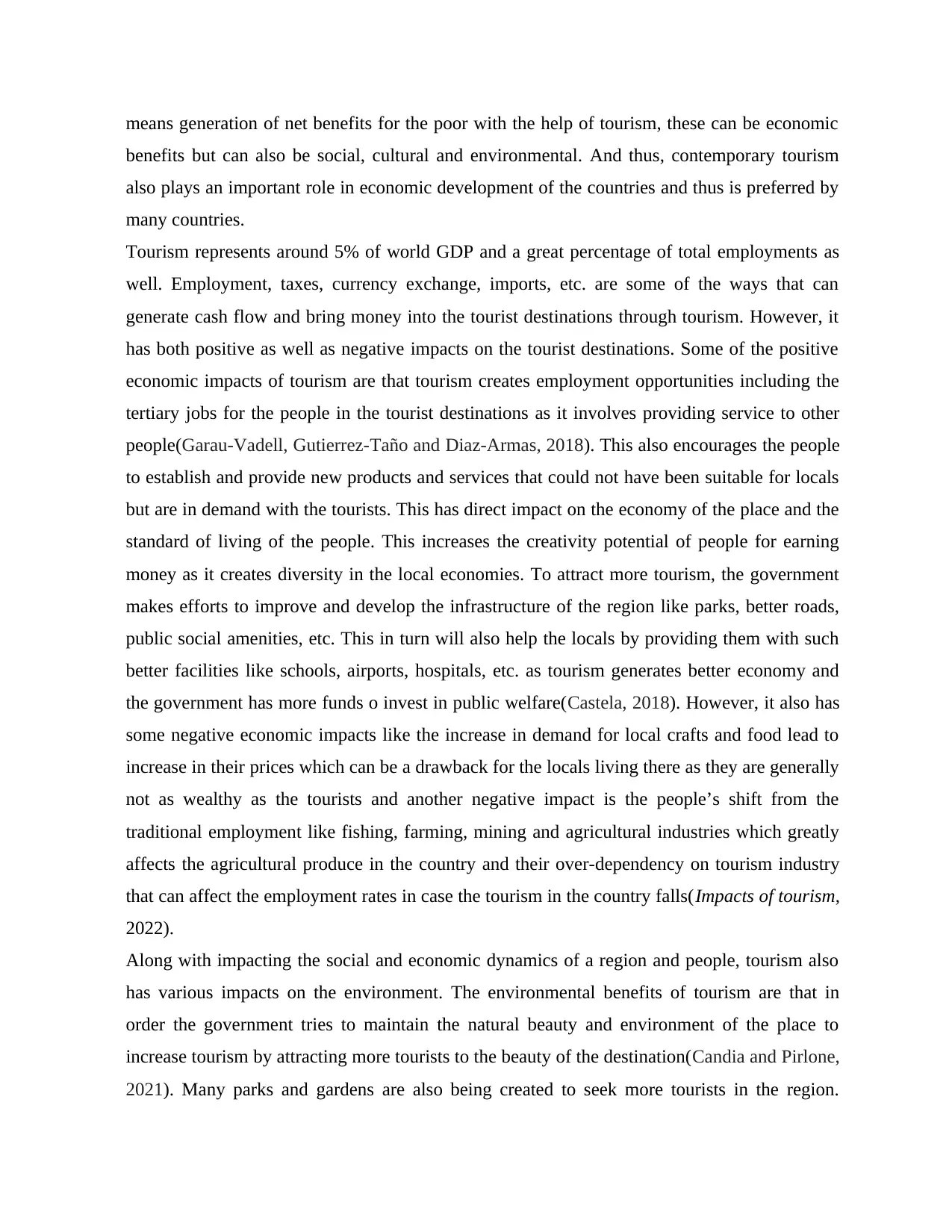
means generation of net benefits for the poor with the help of tourism, these can be economic
benefits but can also be social, cultural and environmental. And thus, contemporary tourism
also plays an important role in economic development of the countries and thus is preferred by
many countries.
Tourism represents around 5% of world GDP and a great percentage of total employments as
well. Employment, taxes, currency exchange, imports, etc. are some of the ways that can
generate cash flow and bring money into the tourist destinations through tourism. However, it
has both positive as well as negative impacts on the tourist destinations. Some of the positive
economic impacts of tourism are that tourism creates employment opportunities including the
tertiary jobs for the people in the tourist destinations as it involves providing service to other
people(Garau-Vadell, Gutierrez-Taño and Diaz-Armas, 2018). This also encourages the people
to establish and provide new products and services that could not have been suitable for locals
but are in demand with the tourists. This has direct impact on the economy of the place and the
standard of living of the people. This increases the creativity potential of people for earning
money as it creates diversity in the local economies. To attract more tourism, the government
makes efforts to improve and develop the infrastructure of the region like parks, better roads,
public social amenities, etc. This in turn will also help the locals by providing them with such
better facilities like schools, airports, hospitals, etc. as tourism generates better economy and
the government has more funds o invest in public welfare(Castela, 2018). However, it also has
some negative economic impacts like the increase in demand for local crafts and food lead to
increase in their prices which can be a drawback for the locals living there as they are generally
not as wealthy as the tourists and another negative impact is the people’s shift from the
traditional employment like fishing, farming, mining and agricultural industries which greatly
affects the agricultural produce in the country and their over-dependency on tourism industry
that can affect the employment rates in case the tourism in the country falls(Impacts of tourism,
2022).
Along with impacting the social and economic dynamics of a region and people, tourism also
has various impacts on the environment. The environmental benefits of tourism are that in
order the government tries to maintain the natural beauty and environment of the place to
increase tourism by attracting more tourists to the beauty of the destination(Candia and Pirlone,
2021). Many parks and gardens are also being created to seek more tourists in the region.
benefits but can also be social, cultural and environmental. And thus, contemporary tourism
also plays an important role in economic development of the countries and thus is preferred by
many countries.
Tourism represents around 5% of world GDP and a great percentage of total employments as
well. Employment, taxes, currency exchange, imports, etc. are some of the ways that can
generate cash flow and bring money into the tourist destinations through tourism. However, it
has both positive as well as negative impacts on the tourist destinations. Some of the positive
economic impacts of tourism are that tourism creates employment opportunities including the
tertiary jobs for the people in the tourist destinations as it involves providing service to other
people(Garau-Vadell, Gutierrez-Taño and Diaz-Armas, 2018). This also encourages the people
to establish and provide new products and services that could not have been suitable for locals
but are in demand with the tourists. This has direct impact on the economy of the place and the
standard of living of the people. This increases the creativity potential of people for earning
money as it creates diversity in the local economies. To attract more tourism, the government
makes efforts to improve and develop the infrastructure of the region like parks, better roads,
public social amenities, etc. This in turn will also help the locals by providing them with such
better facilities like schools, airports, hospitals, etc. as tourism generates better economy and
the government has more funds o invest in public welfare(Castela, 2018). However, it also has
some negative economic impacts like the increase in demand for local crafts and food lead to
increase in their prices which can be a drawback for the locals living there as they are generally
not as wealthy as the tourists and another negative impact is the people’s shift from the
traditional employment like fishing, farming, mining and agricultural industries which greatly
affects the agricultural produce in the country and their over-dependency on tourism industry
that can affect the employment rates in case the tourism in the country falls(Impacts of tourism,
2022).
Along with impacting the social and economic dynamics of a region and people, tourism also
has various impacts on the environment. The environmental benefits of tourism are that in
order the government tries to maintain the natural beauty and environment of the place to
increase tourism by attracting more tourists to the beauty of the destination(Candia and Pirlone,
2021). Many parks and gardens are also being created to seek more tourists in the region.
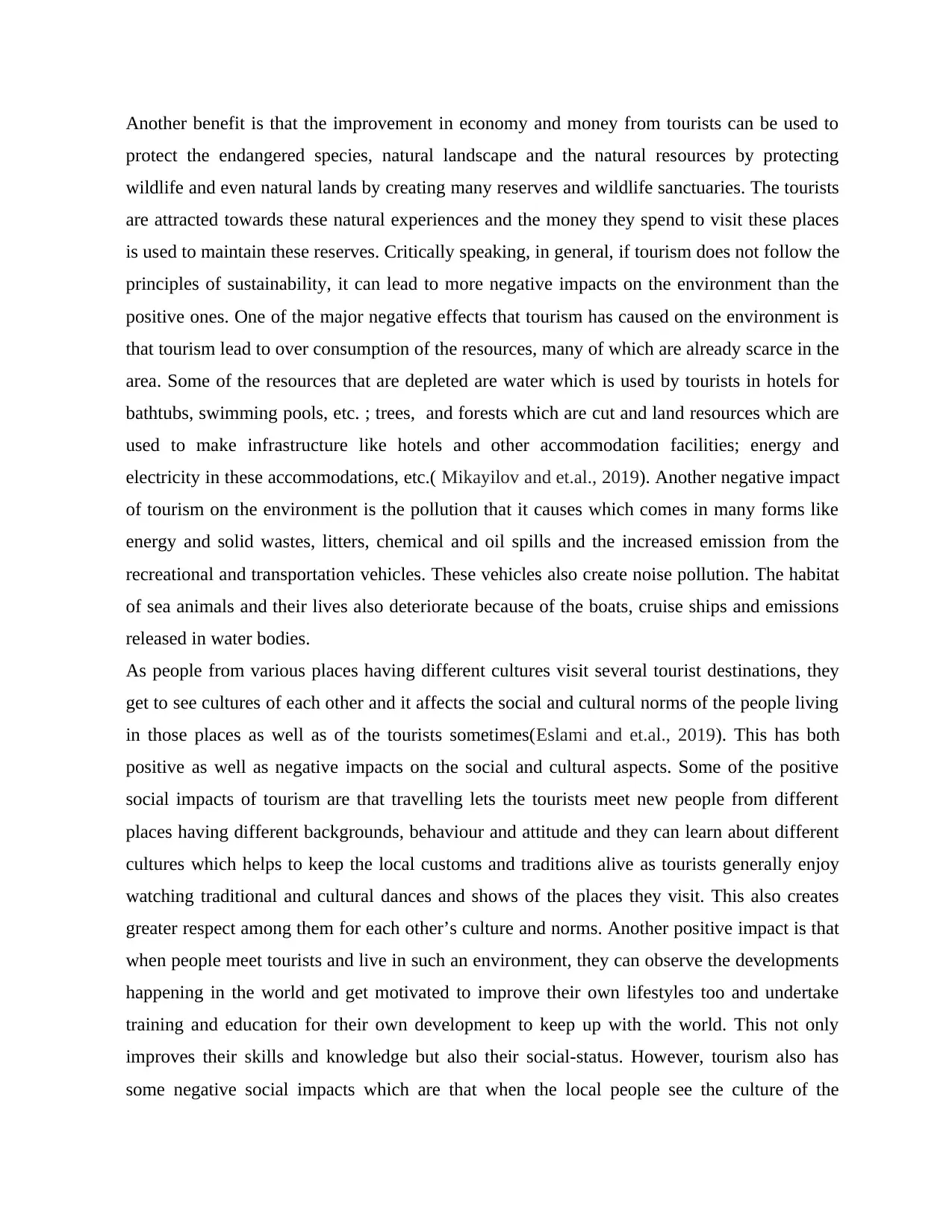
Another benefit is that the improvement in economy and money from tourists can be used to
protect the endangered species, natural landscape and the natural resources by protecting
wildlife and even natural lands by creating many reserves and wildlife sanctuaries. The tourists
are attracted towards these natural experiences and the money they spend to visit these places
is used to maintain these reserves. Critically speaking, in general, if tourism does not follow the
principles of sustainability, it can lead to more negative impacts on the environment than the
positive ones. One of the major negative effects that tourism has caused on the environment is
that tourism lead to over consumption of the resources, many of which are already scarce in the
area. Some of the resources that are depleted are water which is used by tourists in hotels for
bathtubs, swimming pools, etc. ; trees, and forests which are cut and land resources which are
used to make infrastructure like hotels and other accommodation facilities; energy and
electricity in these accommodations, etc.( Mikayilov and et.al., 2019). Another negative impact
of tourism on the environment is the pollution that it causes which comes in many forms like
energy and solid wastes, litters, chemical and oil spills and the increased emission from the
recreational and transportation vehicles. These vehicles also create noise pollution. The habitat
of sea animals and their lives also deteriorate because of the boats, cruise ships and emissions
released in water bodies.
As people from various places having different cultures visit several tourist destinations, they
get to see cultures of each other and it affects the social and cultural norms of the people living
in those places as well as of the tourists sometimes(Eslami and et.al., 2019). This has both
positive as well as negative impacts on the social and cultural aspects. Some of the positive
social impacts of tourism are that travelling lets the tourists meet new people from different
places having different backgrounds, behaviour and attitude and they can learn about different
cultures which helps to keep the local customs and traditions alive as tourists generally enjoy
watching traditional and cultural dances and shows of the places they visit. This also creates
greater respect among them for each other’s culture and norms. Another positive impact is that
when people meet tourists and live in such an environment, they can observe the developments
happening in the world and get motivated to improve their own lifestyles too and undertake
training and education for their own development to keep up with the world. This not only
improves their skills and knowledge but also their social-status. However, tourism also has
some negative social impacts which are that when the local people see the culture of the
protect the endangered species, natural landscape and the natural resources by protecting
wildlife and even natural lands by creating many reserves and wildlife sanctuaries. The tourists
are attracted towards these natural experiences and the money they spend to visit these places
is used to maintain these reserves. Critically speaking, in general, if tourism does not follow the
principles of sustainability, it can lead to more negative impacts on the environment than the
positive ones. One of the major negative effects that tourism has caused on the environment is
that tourism lead to over consumption of the resources, many of which are already scarce in the
area. Some of the resources that are depleted are water which is used by tourists in hotels for
bathtubs, swimming pools, etc. ; trees, and forests which are cut and land resources which are
used to make infrastructure like hotels and other accommodation facilities; energy and
electricity in these accommodations, etc.( Mikayilov and et.al., 2019). Another negative impact
of tourism on the environment is the pollution that it causes which comes in many forms like
energy and solid wastes, litters, chemical and oil spills and the increased emission from the
recreational and transportation vehicles. These vehicles also create noise pollution. The habitat
of sea animals and their lives also deteriorate because of the boats, cruise ships and emissions
released in water bodies.
As people from various places having different cultures visit several tourist destinations, they
get to see cultures of each other and it affects the social and cultural norms of the people living
in those places as well as of the tourists sometimes(Eslami and et.al., 2019). This has both
positive as well as negative impacts on the social and cultural aspects. Some of the positive
social impacts of tourism are that travelling lets the tourists meet new people from different
places having different backgrounds, behaviour and attitude and they can learn about different
cultures which helps to keep the local customs and traditions alive as tourists generally enjoy
watching traditional and cultural dances and shows of the places they visit. This also creates
greater respect among them for each other’s culture and norms. Another positive impact is that
when people meet tourists and live in such an environment, they can observe the developments
happening in the world and get motivated to improve their own lifestyles too and undertake
training and education for their own development to keep up with the world. This not only
improves their skills and knowledge but also their social-status. However, tourism also has
some negative social impacts which are that when the local people see the culture of the
Secure Best Marks with AI Grader
Need help grading? Try our AI Grader for instant feedback on your assignments.
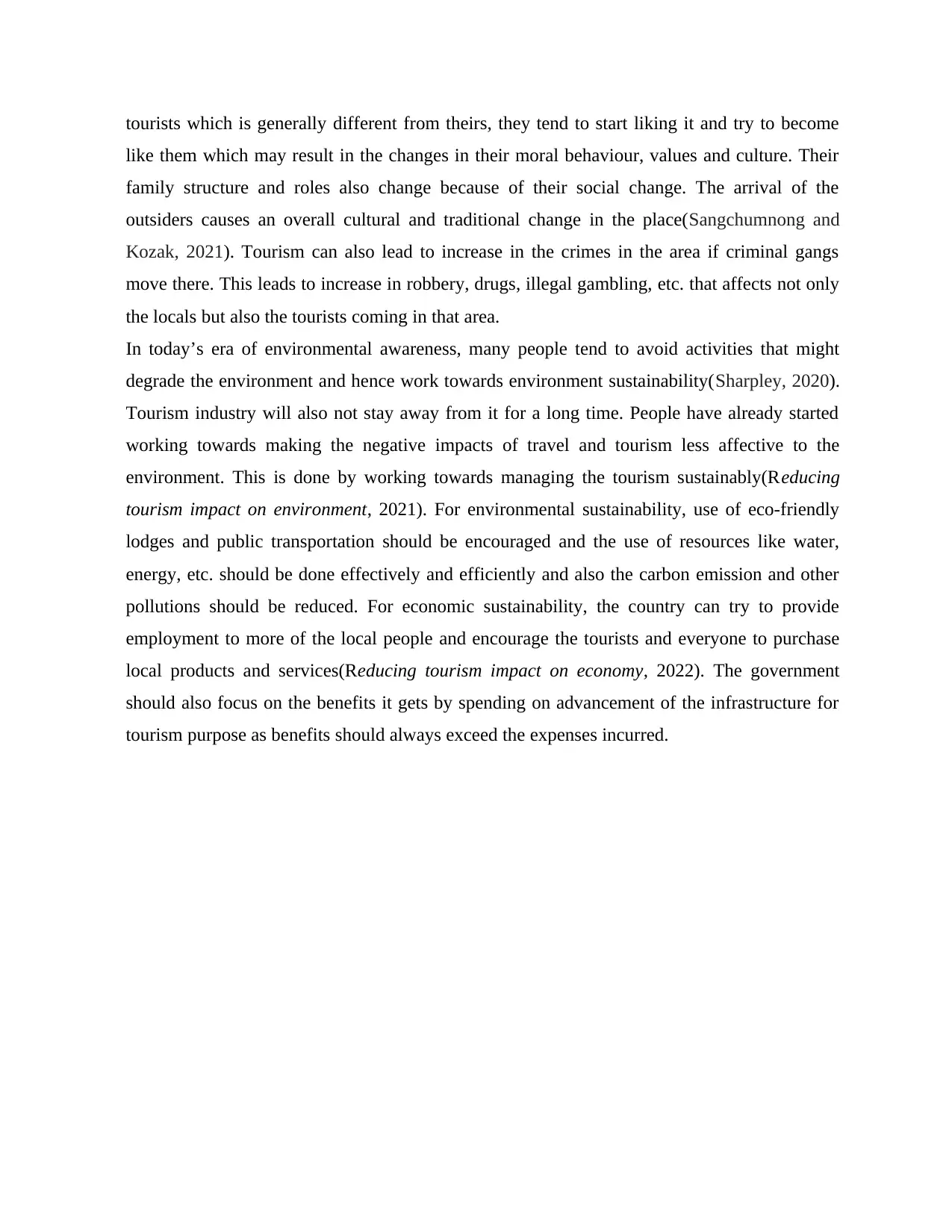
tourists which is generally different from theirs, they tend to start liking it and try to become
like them which may result in the changes in their moral behaviour, values and culture. Their
family structure and roles also change because of their social change. The arrival of the
outsiders causes an overall cultural and traditional change in the place(Sangchumnong and
Kozak, 2021). Tourism can also lead to increase in the crimes in the area if criminal gangs
move there. This leads to increase in robbery, drugs, illegal gambling, etc. that affects not only
the locals but also the tourists coming in that area.
In today’s era of environmental awareness, many people tend to avoid activities that might
degrade the environment and hence work towards environment sustainability(Sharpley, 2020).
Tourism industry will also not stay away from it for a long time. People have already started
working towards making the negative impacts of travel and tourism less affective to the
environment. This is done by working towards managing the tourism sustainably(Reducing
tourism impact on environment, 2021). For environmental sustainability, use of eco-friendly
lodges and public transportation should be encouraged and the use of resources like water,
energy, etc. should be done effectively and efficiently and also the carbon emission and other
pollutions should be reduced. For economic sustainability, the country can try to provide
employment to more of the local people and encourage the tourists and everyone to purchase
local products and services(Reducing tourism impact on economy, 2022). The government
should also focus on the benefits it gets by spending on advancement of the infrastructure for
tourism purpose as benefits should always exceed the expenses incurred.
like them which may result in the changes in their moral behaviour, values and culture. Their
family structure and roles also change because of their social change. The arrival of the
outsiders causes an overall cultural and traditional change in the place(Sangchumnong and
Kozak, 2021). Tourism can also lead to increase in the crimes in the area if criminal gangs
move there. This leads to increase in robbery, drugs, illegal gambling, etc. that affects not only
the locals but also the tourists coming in that area.
In today’s era of environmental awareness, many people tend to avoid activities that might
degrade the environment and hence work towards environment sustainability(Sharpley, 2020).
Tourism industry will also not stay away from it for a long time. People have already started
working towards making the negative impacts of travel and tourism less affective to the
environment. This is done by working towards managing the tourism sustainably(Reducing
tourism impact on environment, 2021). For environmental sustainability, use of eco-friendly
lodges and public transportation should be encouraged and the use of resources like water,
energy, etc. should be done effectively and efficiently and also the carbon emission and other
pollutions should be reduced. For economic sustainability, the country can try to provide
employment to more of the local people and encourage the tourists and everyone to purchase
local products and services(Reducing tourism impact on economy, 2022). The government
should also focus on the benefits it gets by spending on advancement of the infrastructure for
tourism purpose as benefits should always exceed the expenses incurred.
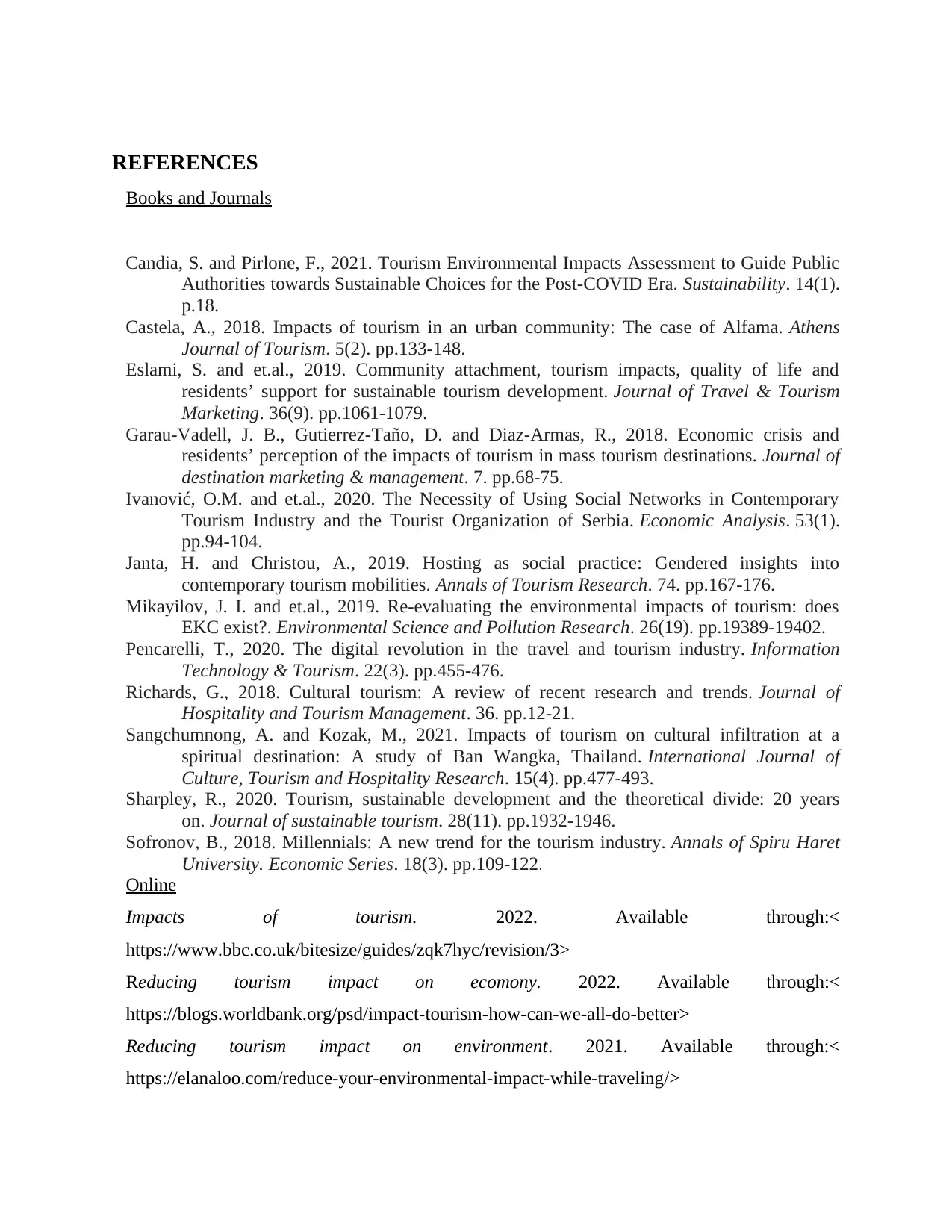
REFERENCES
Books and Journals
Candia, S. and Pirlone, F., 2021. Tourism Environmental Impacts Assessment to Guide Public
Authorities towards Sustainable Choices for the Post-COVID Era. Sustainability. 14(1).
p.18.
Castela, A., 2018. Impacts of tourism in an urban community: The case of Alfama. Athens
Journal of Tourism. 5(2). pp.133-148.
Eslami, S. and et.al., 2019. Community attachment, tourism impacts, quality of life and
residents’ support for sustainable tourism development. Journal of Travel & Tourism
Marketing. 36(9). pp.1061-1079.
Garau-Vadell, J. B., Gutierrez-Taño, D. and Diaz-Armas, R., 2018. Economic crisis and
residents’ perception of the impacts of tourism in mass tourism destinations. Journal of
destination marketing & management. 7. pp.68-75.
Ivanović, O.M. and et.al., 2020. The Necessity of Using Social Networks in Contemporary
Tourism Industry and the Tourist Organization of Serbia. Economic Analysis. 53(1).
pp.94-104.
Janta, H. and Christou, A., 2019. Hosting as social practice: Gendered insights into
contemporary tourism mobilities. Annals of Tourism Research. 74. pp.167-176.
Mikayilov, J. I. and et.al., 2019. Re-evaluating the environmental impacts of tourism: does
EKC exist?. Environmental Science and Pollution Research. 26(19). pp.19389-19402.
Pencarelli, T., 2020. The digital revolution in the travel and tourism industry. Information
Technology & Tourism. 22(3). pp.455-476.
Richards, G., 2018. Cultural tourism: A review of recent research and trends. Journal of
Hospitality and Tourism Management. 36. pp.12-21.
Sangchumnong, A. and Kozak, M., 2021. Impacts of tourism on cultural infiltration at a
spiritual destination: A study of Ban Wangka, Thailand. International Journal of
Culture, Tourism and Hospitality Research. 15(4). pp.477-493.
Sharpley, R., 2020. Tourism, sustainable development and the theoretical divide: 20 years
on. Journal of sustainable tourism. 28(11). pp.1932-1946.
Sofronov, B., 2018. Millennials: A new trend for the tourism industry. Annals of Spiru Haret
University. Economic Series. 18(3). pp.109-122.
Online
Impacts of tourism. 2022. Available through:<
https://www.bbc.co.uk/bitesize/guides/zqk7hyc/revision/3>
Reducing tourism impact on ecomony. 2022. Available through:<
https://blogs.worldbank.org/psd/impact-tourism-how-can-we-all-do-better>
Reducing tourism impact on environment. 2021. Available through:<
https://elanaloo.com/reduce-your-environmental-impact-while-traveling/>
Books and Journals
Candia, S. and Pirlone, F., 2021. Tourism Environmental Impacts Assessment to Guide Public
Authorities towards Sustainable Choices for the Post-COVID Era. Sustainability. 14(1).
p.18.
Castela, A., 2018. Impacts of tourism in an urban community: The case of Alfama. Athens
Journal of Tourism. 5(2). pp.133-148.
Eslami, S. and et.al., 2019. Community attachment, tourism impacts, quality of life and
residents’ support for sustainable tourism development. Journal of Travel & Tourism
Marketing. 36(9). pp.1061-1079.
Garau-Vadell, J. B., Gutierrez-Taño, D. and Diaz-Armas, R., 2018. Economic crisis and
residents’ perception of the impacts of tourism in mass tourism destinations. Journal of
destination marketing & management. 7. pp.68-75.
Ivanović, O.M. and et.al., 2020. The Necessity of Using Social Networks in Contemporary
Tourism Industry and the Tourist Organization of Serbia. Economic Analysis. 53(1).
pp.94-104.
Janta, H. and Christou, A., 2019. Hosting as social practice: Gendered insights into
contemporary tourism mobilities. Annals of Tourism Research. 74. pp.167-176.
Mikayilov, J. I. and et.al., 2019. Re-evaluating the environmental impacts of tourism: does
EKC exist?. Environmental Science and Pollution Research. 26(19). pp.19389-19402.
Pencarelli, T., 2020. The digital revolution in the travel and tourism industry. Information
Technology & Tourism. 22(3). pp.455-476.
Richards, G., 2018. Cultural tourism: A review of recent research and trends. Journal of
Hospitality and Tourism Management. 36. pp.12-21.
Sangchumnong, A. and Kozak, M., 2021. Impacts of tourism on cultural infiltration at a
spiritual destination: A study of Ban Wangka, Thailand. International Journal of
Culture, Tourism and Hospitality Research. 15(4). pp.477-493.
Sharpley, R., 2020. Tourism, sustainable development and the theoretical divide: 20 years
on. Journal of sustainable tourism. 28(11). pp.1932-1946.
Sofronov, B., 2018. Millennials: A new trend for the tourism industry. Annals of Spiru Haret
University. Economic Series. 18(3). pp.109-122.
Online
Impacts of tourism. 2022. Available through:<
https://www.bbc.co.uk/bitesize/guides/zqk7hyc/revision/3>
Reducing tourism impact on ecomony. 2022. Available through:<
https://blogs.worldbank.org/psd/impact-tourism-how-can-we-all-do-better>
Reducing tourism impact on environment. 2021. Available through:<
https://elanaloo.com/reduce-your-environmental-impact-while-traveling/>

1 out of 7
Your All-in-One AI-Powered Toolkit for Academic Success.
+13062052269
info@desklib.com
Available 24*7 on WhatsApp / Email
![[object Object]](/_next/static/media/star-bottom.7253800d.svg)
Unlock your academic potential
© 2024 | Zucol Services PVT LTD | All rights reserved.



